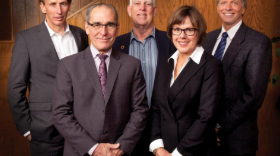It was a little over a century ago that Park City, the United States and the world was hammered by a pandemic.
We talked to Larry Warren, local historian and former KPCW General Manager, about how our town, then a mining community, dealt with the Spanish influenza.
Warren said the flu epidemic started in Kansas in 1918 and spread around the country.
Ultimately, a quarter of the world’s population became infected, and somewhere between 17 and 50 million people died in 1918 and 1919.
Warren recently wrote about the pandemic for the Park Record’s “Way We Were” feature. He researched the online archive for Utah papers to see how the Record reported the epidemic in the winter of 1918 to 19.
He said that, remarkably, the town employed the same shutdown methods being seen today.
“The mayor ordered people to wear masks. Six-layer gauze masks is what he said people ought to wear and that they ought to boil their mask every day. The town was essentially closed down. There was more illness in Heber and in Salt Lake. And the mayor said no one could come into town from those places. Also, school was let out in November and December. So school was out nearly two full months. Schools re-opened December 30th when the number of cases went down.”
Warren said that 70 residents of Park City were infected with the Spanish flu, and some 15 to 20 died.
“In those days, mining was going full tilt, and there were a lot of people with compromised lungs—the miners, who breathed in rock dust every day, had miner’s consumption, which made it difficult to breathe anyway. So they were probably compromised and were among the dead.”
The pandemic brought controversy. Local doctors disagreed on how severe the shutdown should be.
Quarantines also prompted protests.
“When someone had a flu patient in their home, that home was quarantined with a sign posted that no one should come in or out. One of the gossip columns, the Park Float was the name of the column. It said, “People are treating the quarantine as a joke. And it pretty much is a joke,” without further elaboration. So apparently that rule was frequently violated.”
On the lighter side, Warren said that pool rooms and bars, converted to soft drink parlors, escaped the shutdown—for a little while, anyway.
“Soft drink was what bars turned to, when Prohibition—which started earlier in Utah than the nation---when a lot of bars converted to soft-drink parlors. And they remained open while everything else was closed. So somebody ratted them out to the State Health Director. And he made sure, he ordered the pool halls, the soft-drink parlors closed as well.”
Historian Larry Warren, who added there could be a moral in Park City’s lifting of its shutdown on January 1st, 1919. Shortly afterward, 22 new cases popped up, and the town had to shut down again. After that, Warren added, the new cases ran their course in just a couple of weeks.





